Greatest Tragedy in
Crawford County History
Greatest Tragedy in Crawford County History
Reprinted from the January 7,
2010, edition of "The Georgia Post."
By
Billy Powell
Powell, a newspaper columnist and author, has a
penchant for history and loves to research and write about people, places, and
events from the past.
Occupants blown to bits
The December 3, 1942, issue of the “Georgia Post,” reports the following
account of a plane crash: “Of many tragedies occurring in our midst in past
years, none surpass the horrible one of last week, in which two fliers lost
their lives in a wooded area seven miles south of Roberta. When noticed by
observers, the plane was enveloped in flames and immediately crashed to earth.
Upon impact, the plane and the bodies of its occupants were blown to bits. The
pieces of human flesh were too small to be recognized as being parts of a man’s
body. ”
Talk of the Town
This plane crash was” the talk of the town” in Crawford County and adjoining
counties for many years. My wife, Beverly, grew up listening to her grandfather
Lewis Taylor Cummings, a farm overseer, regale her with tales of a military
aircraft that crashed on a rainy, overcast day in November 1942. The plane
crashed a short distance from his farm house near the Magnolia Swamp. Note: The
swampy area of the Flint River basin lying north of old Georgia Highway 96 is
known as the Magnolia Swamp and the swamp south of the highway is called the
Beechwood Swamp.
Sidney Goodrich remembers his grandmother, Mrs. Jennie Reed, the postmaster
and operator of a country store and train depot at Gaillard, describe a plane
that kept circling above her store, its engine sputtering, and then hearing a
loud explosion in the distance. Mrs. Jennie said, within a short time, Carl
Brown, who worked at nearby Sand Pit, came to her home and asked to use the
phone. Evidently, he called Cochran Army Air Field to report the accident as
military personnel soon arrived on the scene. Note: Cochran Field (now Middle
Georgia Regional Airport south of Macon) was originally an Army Air Force base
where British Royal Air Force pilots were trained. It was activated on May 15,
1941. Over 100 BT-13 and BT-15 trainer aircraft were assigned there. Cochran
Field was deactivated on December 15, 1945. The War Department did not approve
construction of a depot at Wellston, Georgia, until June 1941; consequently,
construction of Robins Air Force Base had not been completed at the time of the
November 1942 plane crash.
On the afternoon of the crash, Estelle Peed Pyles came with her father, Felix
Peed, her mother Thelma Farr Peed, and little sister Elizabeth Peed Sanders to
view the crash site. The carnage that Estelle and Elizabeth witnessed is
described later.
Calvin Weaver, who cut timber for 46 years in the Magnolia Swamp with Felton
Cummings and James Gray Cummings, remembers seeing metal components of the plane
scattered across the landscape. Weaver said the plane crashed inside a wooded
area, which bordered an open field.
Statement of Eyewitness: Hoke Ross
A signed, type-written affidavit by Hoke Ross of Crawford County, dated 23
November 1942, the day of crash, states: “The aircraft came over the house I was
at, just above the trees. It was already on fire. It made an awful noise when it
crashed about 600 yards west of house.”
The house where Hoke Ross spotted the plane is thought to be the home of Lewis
Taylor Cummings (Beverly’s grandfather) who farmed there during the 1930s-40s.
Cummings and his family lived in a big, two-story house, called the “Howard
Place,” owned by Troupe Howard, owner of the Howard Theater in Atlanta during
the 1920s. During the 1920s, Howard would throw big parties there on weekends.
His friends would travel by train to Gaillard and then go by house and buggy to
Howard’s house, located 2 miles southwest of Sidney Goodrich’s home at Gaillard.
At that time, a river road to the Magnolia Swamp (now closed) started between
Sidney’s house and Dan Scarborough’s house. It proceeded three miles through the
woods in the direction of Flint River. Howard’s house was two miles down that
road. Crawford Countians jokingly called the Howard Place the “Good Time House”
because of the parties held there by the rich Atlantians.
Official Army Air Force Report
The Army Air Force Investigative Board reported the following findings on 30
November 1942:
Aircraft tail number 42-6771, an A-24A dive bomber, single engine
aircraft, took off from Hunter Field at Savannah Army Air Force Base at 1439
Zulu time (8:39 A.M.) on 23 November 1942 to fly to New Orleans. Fight time was
estimated at 3.5 hours.
Pilot was 1st Lieutenant Reynolds H. Middleton with Master Sergeant David L.
Dean as passenger.
Plane crashed seven miles south of Roberta at 1715 Zulu time (11:15 A.M.)
Aircraft was completely destroyed upon impact and both occupants killed. Plane
struck the ground in vertical position and fuel tanks exploded into flames,
causing complete disintegration of the aircraft and dissolution of the bodies of
Middleton and Dean—meaning they were blown to smithereens.
The weather report shows it was raining and foggy. The cloud ceiling was 500
feet; visibility limited to 4 miles.
Pilot was 60 miles north of flight plan and 75 minutes behind schedule. Due to
overcast conditions and limited visibility, pilot was flying by instruments.
The accident report, signed by a lieutenant colonel, major, and captain,
concluded it was impossible to determine the exact cause of the crash. Although
loss of orientation, being behind schedule and off course due to weather
conditions, was a factor, the board possessed no information regarding equipment
failures.
Witnesses Implicate Engine Failure
Based on the testimony of witnesses, engine failure may have contributed to
the crash. Mrs. Jennie Reed heard the plane’s engine cutting out and sputtering
moments before the crash. Hoke Ross saw flames coming from the plane, which
indicated the engine was on fire as the plane plunged to earth.
Awful Stench of Burning Flesh
On the afternoon of the crash, Felix Peed, who operated a saw mill and lived
in the Magnolia area near the Flint River, carried his wife, Thelma, and
daughters Estelle (age 17) and Elizabeth (age 10), to the crash site to view the
damage. Estelle recalls seeing a deep smoking crater in ground where the plane
hit. Parts of the plane were strewn across the ground. Smoldering patches of
human flesh were scattered throughout the crash area. Estelle inadvertently
stepped on a piece of human flesh and heard a bone snap. She immediately jumped,
thinking she had crushed the spine of one of the fliers. Horrified by the
carnage before her eyes and fearful of stepping on human body parts, Estelle
implored her father to leave. Her younger sister Elizabeth to this day still
remembers the awful stench of burning human flesh.
Body Parts Commingled and Scattered
The body parts of Lt. Middleton and Sergeant Dean were commingled and
scattered across the ground-- into so many small pieces that they could not be
identified as to whom they belonged or assembled into a casket for burial. For
this reason, a memorial service was held…
Memorial Service held at Crash Site
Excerpts from the January 21, 1943, edition of the “Georgia Post”: “A
memorial service was conducted at the crash site by an Army Air Force chaplain.
A cross was placed there to mark the spot where the tragedy occurred…First
Lieutenant Reynolds Middleton, age 24, a native of Arkansas, had wired his
parents before leaving Savannah that he would sleep at their home that night.
His parents, Mr. and Mrs. Ed Middleton of Conway, Arkansas, had made special
preparations for his coming…The Middletons showed unusual courage and the real
patriotic bravery that so many parents are being called upon to command in these
troublesome times…Accompanying Mr. and Mrs. Middleton (to memorial service) were
a son, Frederick Middleton and Miss June Middleton of Conway, Arkansas, and Mrs.
Faye Sneed of Clinton, Arkansas.”
Calvin Weaver discovers Memorial Cross
About two years after the tragedy, Calvin Weaver was logging in the area of
the crash site with Felton Cummings and James Gray Cummings. They were cutting
timber in a wooded area of Magnolia Swamp near the Flint River when they spotted
the memorial cross referenced above. Felton Cummings had to remove the cross
temporarily to allow access for his log truck to load the timber. Weaver said
the cross was 6-7 feet tall, made of wood, and covered with leather.
Within 20 yards of the cross, Weaver discovered two large metal sections of the
plane, each weighing over 200 pounds. They were thought to be an engine cowling
and a fuselage section catapulted there by the plane’s implosion. Weaver stated
that mules were used to drag the aircraft sections away from the trees, so they
could be cut. Weaver said, in those days, that loggers used either 6’ or 9’
crosscut saws to fell a tree, depending on diameter of the tree.
Another Plane Crash 6 Months Later
There was yet another military plane crash in Crawford County, six months
later—this time a Cochran Field plane. The pilot was killed, but the plane was
partially intact after crash. It occurred on April 26, 1943, in a peach orchid
near Lee Pope, Georgia.
BT-13A Trainer crashes near Lee Pope
The official accident report filed by the Army Air Force at Cochran Field
reads as follows:
“At approximately 1440 Zulu time (8:40 A.M.), Aviation Cadet John H. Cossey
took off from Cochran Field, Georgia, in BT-13A, serial number 41-1627. Cadet
Cossey’s mission was local student airwork.
“At approximately 1510 Zulu time (9:10 A.M.) near Lee Pope, Georgia, his plane
was seen to go into a spin at an estimated altitude of 1500 to 2000 feet. From
the testimony of civilian witnesses, the airplane completed at least three turns
of the spin, failed to recover, and crashed, killing the pilot and completely
wrecking the airplane.
“The only witnesses to the accident were civilians, none of which were familiar
with flying. Therefore, statements by these witnesses as to the altitude at
which the spin started and the behavior of the engine cannot be considered
reliable.
“Aviation Cadet Cossey had received 15 hours training in this type aircraft. He
was thoroughly instructed in spin and stall recovery prior to his solo flight
and was considered fully competent to execute these recoveries.
“Therefore, it is the opinion of this military board that this accident was
caused by failure to recover from a prolonged spin. The reason for entry into
the spin and for the failure to recover from it cannot be determined.”
Damage to Plane
This BT-13A trainer aircraft crashed into a peach orchid near Lee Pope.
Peach trees can be seen in the vicinity of the crash. Photos of the crash show
only the tail section intact. Sheet metal and steel beams comprising the
fuselage and cockpit areas were badly twisted and burned. We have been unable to
locate any witnesses to the accident.
Engine reliability and pilot training
During the WW-II years, 1941-1945, Cochran Army Air Field experienced over
350 aircraft accidents including fatal crashes involving its single-engine,
trainer aircraft, BT-13s and BT-15s. Over 100 trainers were assigned to Cochran
Field. All aircraft mishaps occurred during the performance of training
missions. This large magnitude of accidents naturally surfaces questions
regarding the reliability of engines and the effectiveness of pilot training.
Appreciation to:
Historian Sidney Goodrich- suffered with me thorough disappointment after
disappointment. After thinking the records we were seeking had been found, our
hopes were dashed on three separate occasions. Sidney never gave up and
encouraged me to keep digging.
Librarian Leda Starnes- spent numerous hours searching newspaper archives at the
Crawford County Public Library to find local accounts that would corroborate the
aircraft incidents reflected in Air Force records.
Research Assistant Julie Huskey- to facilitate our research, provided index of
aircraft accidents from the “Macon Telegraph.” Also, copied and emailed copies
of requested newspaper articles from the archives of Mercer University’s Tarver
Library.
Research Analyst Craig Fuller-went above and beyond the call of duty to provide
accident reports from the archives of the Aviation Archaeological Investigation
and Research (AAIR) Center, located in California. Craig helped us avoid many
weeks of research by spooling off only the aircraft accidents occurring in
Georgia during 1941-45. This allowed us to pinpoint the much sought after
11-23-1942 crash near Roberta. Otherwise, it would have been like hunting a
needle in a hay stack to search through the Air Force database of 15,000
aircraft accidents during WW-II.
My appreciation to Crawford County
historian, Sidney Goodrich, and my brother, Dwayne Powell, an accomplished
genealogist. Without their expert help, this story would not have been
possible.
A huge thanks goes out to Mr. Billy Powell for sharing this information and
photos with us!
Click on
the photos for a larger view...
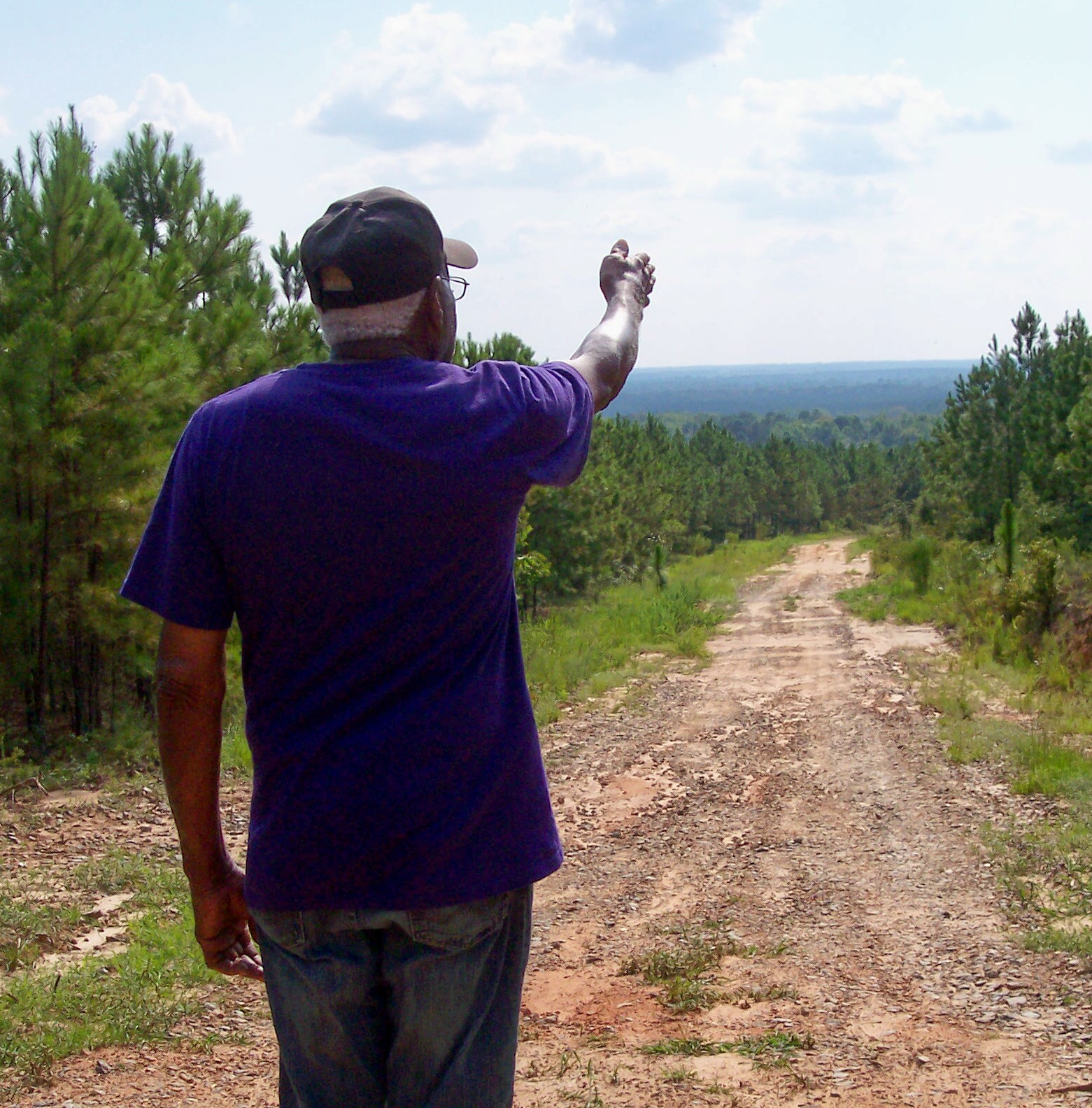
Calvin Weaver points toward crash site. Measured
from the west end of Magnolia Road (off Cummings Road), crash site is
approximately 1.25 miles northwest, near the Flint River swamp.
|
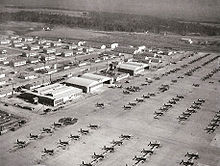 Aerial photo of Cochran Army Air Field in 1942.
Over 100, BT-13 and BT-15 trainers were assigned. British Royal Air Force
pilots were trained there.
Aerial photo of Cochran Army Air Field in 1942.
Over 100, BT-13 and BT-15 trainers were assigned. British Royal Air Force
pilots were trained there. |
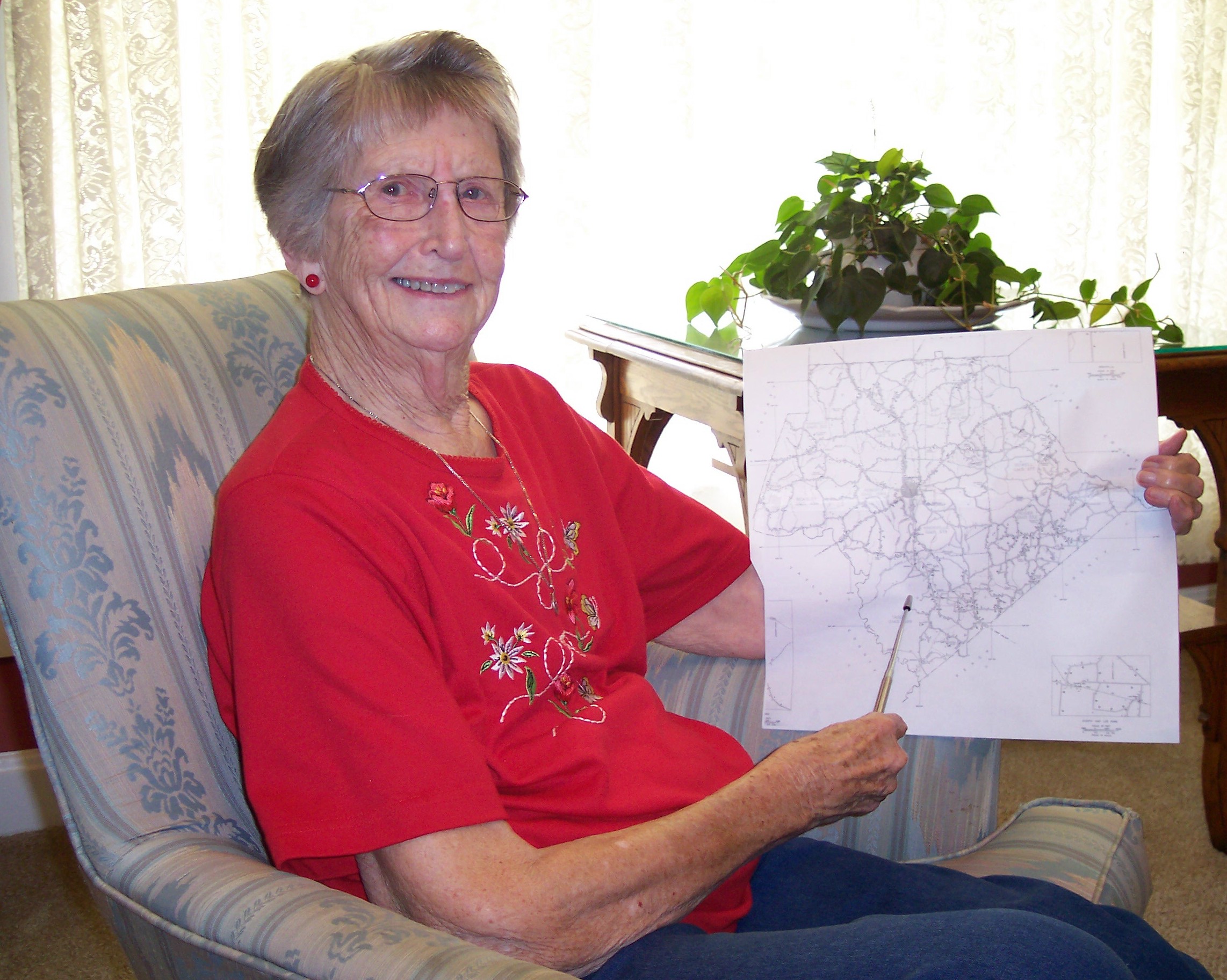 Estelle Pyles, who grew up in Magnolia area of
Flint River, points to crash site on 1939 Crawford County map.
Estelle Pyles, who grew up in Magnolia area of
Flint River, points to crash site on 1939 Crawford County map. |

Calvin Weaver
|
|
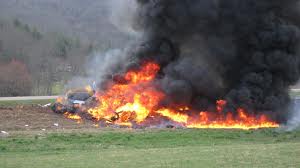 An A-24 dive bomber from Hunter Field, Savannah Army Air Base, crashed on
Nov 23, 1942, seven miles south of Roberta near Magnolia Swamp.The plane
exploded into flames, its fuselage, wings, and tail section dissentegrated
upon impact. Both occupants were killed, their bodies blown to bits. Small
patches of body parts were so scattered and burned they could not be
gathered or identified.
An A-24 dive bomber from Hunter Field, Savannah Army Air Base, crashed on
Nov 23, 1942, seven miles south of Roberta near Magnolia Swamp.The plane
exploded into flames, its fuselage, wings, and tail section dissentegrated
upon impact. Both occupants were killed, their bodies blown to bits. Small
patches of body parts were so scattered and burned they could not be
gathered or identified. |
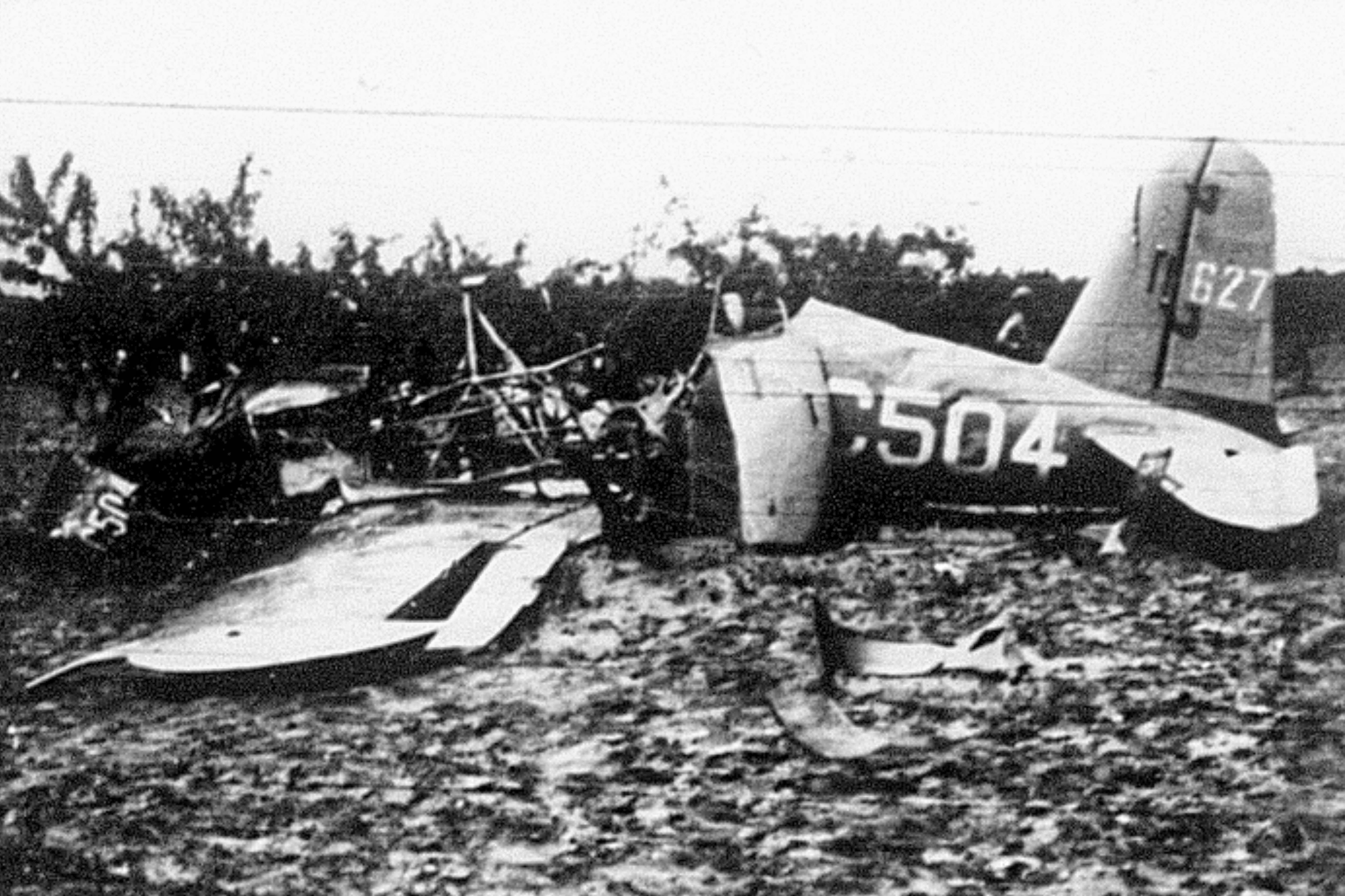 BT-13A crash near Lee Pope, April 26,1943.
BT-13A crash near Lee Pope, April 26,1943. |
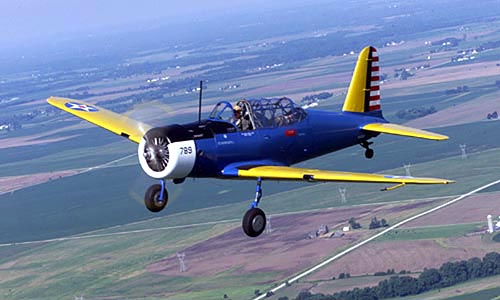 BT-13A Trainer from Cochran Army Air Field.
BT-13A Trainer from Cochran Army Air Field. |
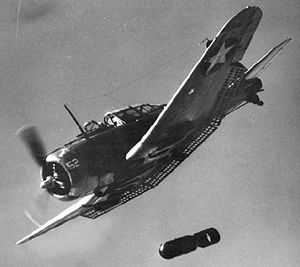 A-24 Dive Bomber drops bomb.
A-24 Dive Bomber drops bomb. |
|
This page was last updated
Wednesday, April 10, 2013
Copyright ©
Kim Gordon ←
Webmaster
All Rights Reserved
Back to Cities &
Towns
Back to Crawford County AHGP

 Aerial photo of Cochran Army Air Field in 1942.
Over 100, BT-13 and BT-15 trainers were assigned. British Royal Air Force
pilots were trained there.
Aerial photo of Cochran Army Air Field in 1942.
Over 100, BT-13 and BT-15 trainers were assigned. British Royal Air Force
pilots were trained there. Estelle Pyles, who grew up in Magnolia area of
Flint River, points to crash site on 1939 Crawford County map.
Estelle Pyles, who grew up in Magnolia area of
Flint River, points to crash site on 1939 Crawford County map.
 An A-24 dive bomber from Hunter Field, Savannah Army Air Base, crashed on
Nov 23, 1942, seven miles south of Roberta near Magnolia Swamp.The plane
exploded into flames, its fuselage, wings, and tail section dissentegrated
upon impact. Both occupants were killed, their bodies blown to bits. Small
patches of body parts were so scattered and burned they could not be
gathered or identified.
An A-24 dive bomber from Hunter Field, Savannah Army Air Base, crashed on
Nov 23, 1942, seven miles south of Roberta near Magnolia Swamp.The plane
exploded into flames, its fuselage, wings, and tail section dissentegrated
upon impact. Both occupants were killed, their bodies blown to bits. Small
patches of body parts were so scattered and burned they could not be
gathered or identified. BT-13A crash near Lee Pope, April 26,1943.
BT-13A crash near Lee Pope, April 26,1943. BT-13A Trainer from Cochran Army Air Field.
BT-13A Trainer from Cochran Army Air Field. A-24 Dive Bomber drops bomb.
A-24 Dive Bomber drops bomb.